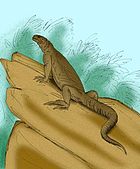Pristiguana
Appearance
| Pristiguana Temporal range: Maastrichtian
~ | |
|---|---|
| Scientific classification | |
| Domain: | Eukaryota |
| Kingdom: | Animalia |
| Phylum: | Chordata |
| Class: | Reptilia |
| Order: | Squamata |
| Genus: | †Pristiguana |
| Species: | †P. brasiliensis
|
| Binomial name | |
| †Pristiguana brasiliensis Estes & Price 1973[1]
| |
Pristiguana is an extinct genus of possible iguanian lizard from the Maastrichtian Marília Formation of Brazil.[1] The type species is P. brasiliensis.
Description
[edit]Pristiguana was discovered in the Bauru Group of Brazil. Its discoverers said, in 1973, that it is originally considered as the oldest fossil lizard in the family Iguanidae. It resembles living primitive South American iguanids in some features, and shares some features with teiids. However, in 2012 study, phylogenic analysis found that it was a primitive iguanian forming a clade with Huehuecuetzpalli (which is considered as stem-squamate in more recent studies[2][3][4]).[5] Later studies questioned its pleurodontan and iguanian affinity.[6][7] The specimen is apparently lost.[8]
References
[edit]- ^ a b Pristiguana at Fossilworks.org
- ^ Simões, Tiago R.; Caldwell, Michael W.; Tałanda, Mateusz; Bernardi, Massimo; Palci, Alessandro; Vernygora, Oksana; Bernardini, Federico; Mancini, Lucia; Nydam, Randall L. (May 2018). "The origin of squamates revealed by a Middle Triassic lizard from the Italian Alps". Nature. 557 (7707): 706–709. Bibcode:2018Natur.557..706S. doi:10.1038/s41586-018-0093-3. ISSN 0028-0836. PMID 29849156. S2CID 44108416.
- ^ Bolet, Arnau; Stubbs, Thomas L; Herrera-Flores, Jorge A; Benton, Michael J (3 May 2022). "The Jurassic rise of squamates as supported by lepidosaur disparity and evolutionary rates". eLife. 11: e66511. doi:10.7554/eLife.66511. ISSN 2050-084X. PMC 9064307. PMID 35502582.
- ^ Tałanda, Mateusz; Fernandez, Vincent; Panciroli, Elsa; Evans, Susan E.; Benson, Roger J. (26 October 2022). "Synchrotron tomography of a stem lizard elucidates early squamate anatomy". Nature. 611 (7934): 99–104. Bibcode:2022Natur.611...99T. doi:10.1038/s41586-022-05332-6. ISSN 0028-0836. PMID 36289329. S2CID 253160713.
- ^ Daza, Juan D.; Abdala, Virginia; Arias, J. Salvador; García-López, Daniel; Ortiz, Pablo (2012). "Cladistic Analysis of Iguania and a Fossil Lizard from the Late Pliocene of Northwestern Argentina". Journal of Herpetology. 46 (1): 104–119. doi:10.1670/10-112. hdl:11336/61054. ISSN 0022-1511.
- ^ Albino, Adriana María; Brizuela, Santiago (2014). "An Overview of the South American Fossil Squamates". The Anatomical Record. 297 (3): 349–368. doi:10.1002/ar.22858. ISSN 1932-8494. PMID 24482358.
- ^ DeMar, David G.; Conrad, Jack L.; Head, Jason J.; Varricchio, David J.; Wilson, Gregory P. (25 January 2017). "A new Late Cretaceous iguanomorph from North America and the origin of New World Pleurodonta (Squamata, Iguania)". Proceedings of the Royal Society B: Biological Sciences. 284 (1847): 20161902. doi:10.1098/rspb.2016.1902. PMC 5310030. PMID 28123087.
- ^ Xing, Lida; Niu, Kecheng; Evans, Susan E. (2023). "A new polyglyphanodontian lizard with a complete lower temporal bar from the Upper Cretaceous of southern China". Journal of Systematic Palaeontology. 21 (1). Bibcode:2023JSPal..2181494X. doi:10.1080/14772019.2023.2281494. ISSN 1477-2019.
Further reading
[edit]- Richard Estes and Llewellyn I. Price, Iguanid Lizard from the Upper Cretaceous of Brazil, Science, 18 May 1973, vol. 180. no. 4087, pp. 748–751 abstract





